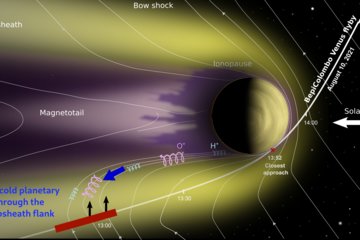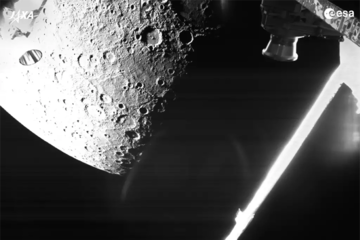All genres
1.
Journal Article
Direct evidence of substorm-related impulsive injections of electrons at Mercury. Nature Communications 14, p. 4019 (2023)
2.
Journal Article
Callisto's Atmosphere and Its Space Environment: Prospects for the Particle Environment Package on Board JUICE. Earth and Space Science 9, p. e02172 (2022)
3.
Journal Article
Spectra of Saturn’s proton belts revealed. Icarus 376, 114795 (2022)
4.
Journal Article
Inner southern magnetosphere observation of Mercury via SERENA ion sensors in BepiColombo mission. Nature Communications 13, p. 7390 (2022)
5.
Journal Article
The in-situ exploration of Jupiter's radiation belts. Experimental Astronomy (2022)
6.
Journal Article
A source of very energetic oxygen located in Jupiter’s inner radiation belts. Science Advances 8 (2), eabm4234 (2022)
7.
Journal Article
Zebra Stripe Patterns in Energetic Ion Spectra at Saturn. Geophysical Research Letters 49, p. e97691 (2022)
8.
Journal Article
A Rotating Azimuthally Distributed Auroral Current System on Saturn Revealed by the Cassini Spacecraft. Astrophysical Journal, Letters 919 (2), L25 (2021)
9.
Journal Article
Reply to Comment on “An Active Plume Eruption on Europa During Galileo Flyby E26 as Indicated by Energetic Proton Depletions”. Geophysical Research Letters 48 (18), e2021GL095240 (2021)
10.
Journal Article
Dawn‐Dusk Asymmetry in Energetic (>20 keV) Particles Adjacent to Saturn's Magnetopause. Journal of Geophysical Research: Space Physics 126 (2), e2020JA028264 (2021)
11.
Journal Article
SERENA: Particle Instrument Suite for Determining the Sun-Mercury Interaction from BepiColombo. Space Science Reviews 217, 11 (2021)
12.
Journal Article
Correction to: SERENA: Particle Instrument Suite for Determining the Sun-Mercury Interaction from BepiColombo. Space Science Reviews 217, 30 (2021)
13.
Journal Article
Pre-flight Calibration and Near-Earth Commissioning Results of the Mercury Plasma Particle Experiment (MPPE) Onboard MMO (Mio). Space Science Reviews 217 (5), 70 (2021)
14.
Journal Article
Saturn's Inner Magnetospheric Convection in the View of Zebra Stripe Patterns in Energetic Electron Spectra. Journal of Geophysical Research: Space Physics 126 (10), e2021JA029600 (2021)
15.
Journal Article
Cassini Observation of Relativistic Electron Butterfly Distributions in Saturn’s Inner Radiation Belts: Evidence for Acceleration by Local Processes. Geophysical Research Letters 48 (14), e2021GL092690 (2021)
16.
Journal Article
Large-scale episodic enhancements of relativistic electron intensities in Jupiter's radiation belt. Earth and Planetary Physics 5 (4), pp. 314 - 326 (2021)
17.
Journal Article
Joint Europa Mission (JEM) a multi-scale study of Europa to characterize its habitability and search for extant life. Planetary and Space Science 193, 104960 (2020)
18.
Journal Article
Saturn's Nightside Dynamics During Cassini's F Ring and Proximal Orbits: Response to Solar Wind and Planetary Period Oscillation Modulations. Journal of Geophysical Research: Space Physics 125 (9), e2020JA027907 (2020)
19.
Journal Article
The formation of saturn's and jupiter's electron radiation belts by magnetospheric electric fields. The Astrophysical Journal Letters 905 (1), L10 (2020)
20.
Journal Article
An Active Plume Eruption on Europa During Galileo Flyby E26 as Indicated by Energetic Proton Depletions. Geophysical Research Letters 47 (10), e2020GL087806 (2020)











